- Press release
Euro area monthly balance of payments: July 2020
18 September 2020
- In July 2020 the current account of the euro area recorded a surplus of €17 billion, compared with a surplus of €21 billion in June 2020.[1]
- In the 12-month period to July 2020, the current account recorded a surplus of €259 billion (2.2% of euro area GDP), compared with a surplus of €304 billion (2.6% of euro area GDP) in the 12 months to July 2019.
- In the financial account, euro area residents made net acquisitions of foreign portfolio investment securities totalling €487 billion in the 12-month period to July 2020 (up from €160 billion in the 12 months to July 2019). Over the same period, non-residents made net acquisitions of euro area portfolio investment securities amounting to €406 billion (up from €188 billion).
Chart 1
Euro area current account balance
(EUR billions unless otherwise indicated; working day and seasonally adjusted data)
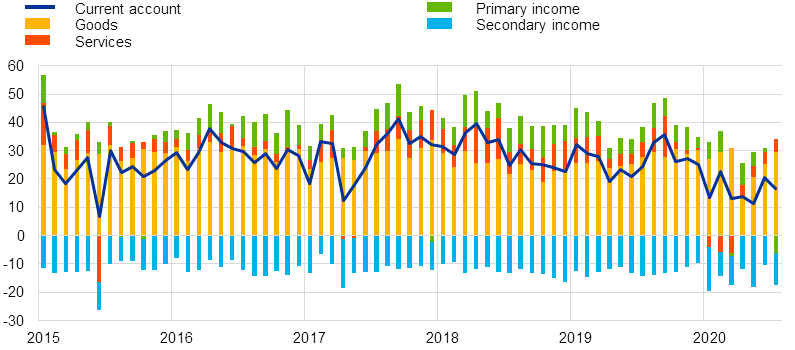
Source: ECB.
The current account of the euro area recorded a surplus of €17 billion in July 2020, decreasing by €4 billion from the previous month (see Chart 1 and Table 1). Surpluses were recorded for goods (€30 billion) and services (€5 billion). Deficits were recorded for secondary income (€11 billion) and primary income (€6 billion).
Table 1
Current account of the euro area
(EUR billions unless otherwise indicated; transactions; working day and seasonally adjusted data)
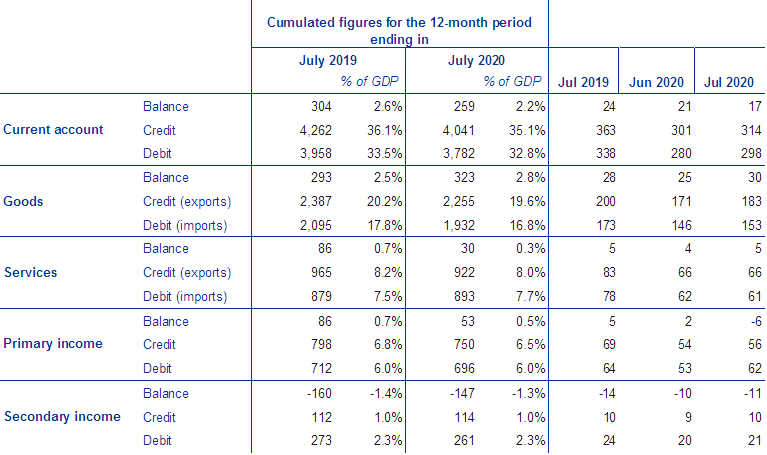
Source: ECB.
Note: Discrepancies between totals and their components may be due to rounding.
In the 12 months to July 2020, the current account recorded a surplus of €259 billion (2.2% of euro area GDP), compared with a surplus of €304 billion (2.6% of euro area GDP) in the 12 months to July 2019. The decline was mainly driven by a reduction in the surplus for services (down from €86 billion to €30 billion), but also by a reduction in the surplus for primary income (down from €86 billion to €53 billion). These developments were partly offset by an increase in the surplus for goods (up from €293 billion to €323 billion) and a decrease in the deficit for secondary income (down from €160 billion to €147 billion).
Chart 2
Selected items of the euro area financial account
(EUR billions; 12-month cumulated data)
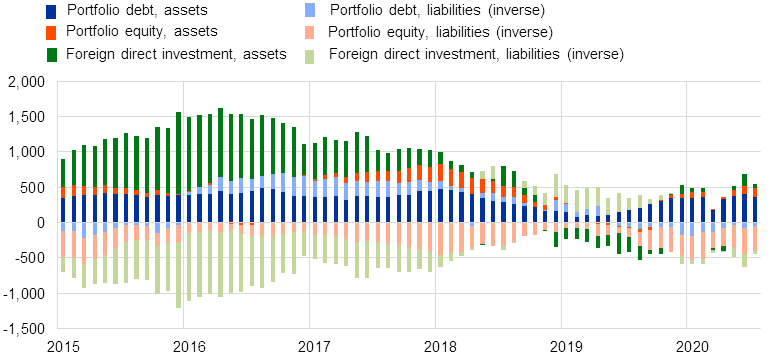
Source: ECB.
Notes: For assets, a positive (negative) number indicates net purchases (sales) of non-euro area instruments by euro area investors. For liabilities, a positive (negative) number indicates net sales (purchases) of euro area instruments by non-euro area investors.
In direct investment, euro area residents made net investments of €54 billion in non-euro area assets in the 12-month period to July 2020, following net disinvestments of €221 billion in the 12 months to July 2019 (see Chart 2 and Table 2). At the same time, non-residents made net investments in euro area assets of €43 billion in the 12-month period to July 2020, following net disinvestments of €172 billion in the 12 months to July 2019.
In portfolio investment, net purchases of foreign debt securities by euro area residents increased to €364 billion in the 12-month period to July 2020, following net purchases of €175 billion in the 12 months to July 2019. Over the same period, euro area residents made net purchases of foreign equity of €123 billion, after recording net sales of €14 billion in the 12 months to July 2019. Non-residents made net purchases of euro area debt securities amounting to €52 billion in the 12 months to July 2020, down from net purchases of €61 billion in the 12 months to July 2019. Over the same period, non-residents’ net purchases of euro area equity rose to €354 billion from €127 billion.
Table 2
Financial account of the euro area
(EUR billions unless otherwise indicated; transactions; non-working day and non-seasonally adjusted data)
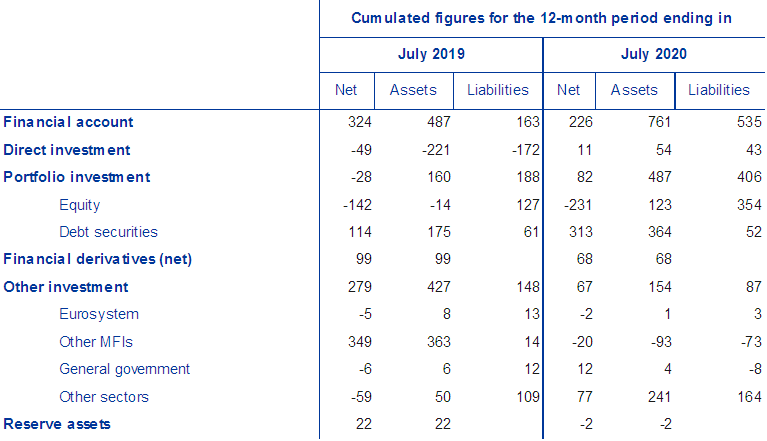
Source: ECB.
Notes: Decreases in assets and liabilities are shown with a minus sign. Net financial derivatives are reported under assets. “MFIs” stands for monetary financial institutions. Discrepancies between totals and their components may be due to rounding.
In other investment, euro area residents’ net acquisitions of foreign assets decreased to €154 billion in the 12 months to July 2020 (following net acquisitions of €427 billion in the 12 months to July 2019), while their net incurrence of liabilities decreased to €87 billion from €148 billion.
Chart 3
Monetary presentation of the balance of payments
(EUR billions; 12-month cumulated data)
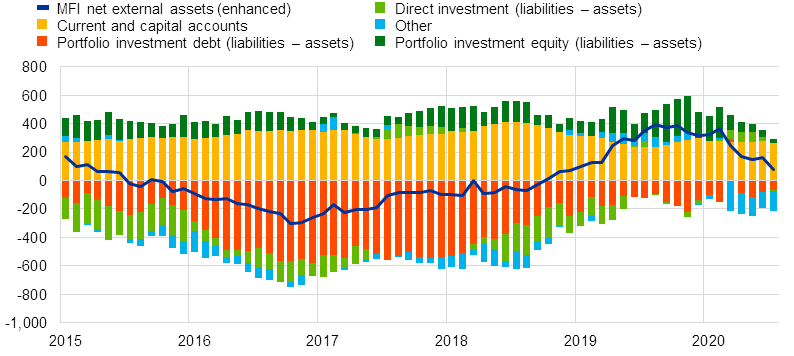
Source: ECB.
Notes: MFI net external assets (enhanced) incorporates an adjustment to the MFI net external assets (as reported in the consolidated MFI balance sheet items statistics) based on information on MFI long-term liabilities held by non-residents, available in balance of payments (b.o.p.) statistics. B.o.p. transactions refer only to transactions of non-MFI residents of the euro area. Financial transactions are shown as liabilities net of assets. “Other” includes financial derivatives, other investment and statistical discrepancies.
The monetary presentation of the balance of payments (see Chart 3) shows that the net external assets (enhanced) of euro area MFIs increased by €78 billion in the 12-month period to July 2020. This increase was mainly driven by the current and capital accounts surplus and, to a lesser extent, by euro area non-MFIs’ net inflows in portfolio investment equity. These developments were partly offset by euro area non-MFIs’ net outflows in portfolio investment debt securities and by other flows (particularly other investment net outflows).
In July 2020 the Eurosystem’s stock of reserve assets increased to €923.1 billion, up from €905.0 billion in the previous month (see Table 3). This increase was driven by positive price changes of monetary gold (€31.1 billion), which were partly offset by negative exchange rate changes (€14.0 billion) and net sales of assets (€0.5 billion).
Table 3
Reserve assets of the euro area
(EUR billions; amounts outstanding at the end of the period, flows during the period; non-working day and non-seasonally adjusted data)

Source: ECB.
Note: “Other reserve assets” comprises currency and deposits, securities, financial derivatives (net) and other claims.
Data revisions
This press release does not incorporate revisions to previous periods.
The production of monthly b.o.p. statistics has in most countries been affected by the COVID-19 crisis. The lockdown measures implemented across the euro area have created challenges for the data collection and compilation process. In addition, the abrupt economic impact of these measures has caused particular difficulties for the estimation of infra-annual data, whose releases are therefore subject to higher uncertainty. More information on the potential impact of the COVID-19 crisis on b.o.p. statistics can be found here.
Next releases:
- quarterly balance of payments and international investment position: 2 October 2020 (reference data up to the second quarter of 2020)
- monthly balance of payments: 20 October 2020 (reference data up to August 2020)
For media queries, please contact Philippe Rispal, tel.: +49 69 1344 5482.
Notes
- Hyperlinks in this press release lead to data that may change with subsequent releases as a result of revisions.
- References to the current account always relate to data that are seasonally and working day-adjusted, unless otherwise indicated, whereas references to the capital and financial accounts relate to data that are neither seasonally nor working day-adjusted.
Banc Ceannais Eorpach
Stiúrthóireacht Cumarsáide
- Sonnemannstrasse 20
- 60314 Frankfurt am Main, an Ghearmáin
- +49 69 1344 7455
- media@ecb.europa.eu
Ceadaítear atáirgeadh ar choinníoll go n-admhaítear an fhoinse.
An Oifig Preasa

